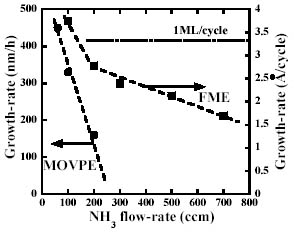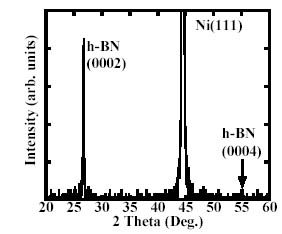Yasuyuki Kobayashi, Tetsuya Akasaka and Toshiki Makimoto
Materials Science Laboratory
Hexagonal boron nitride (h-BN) is one of the promising material systems for optical device applications in the ultraviolet spectral region and for exciton-based quantum information processing because of its wide bandgap and large exciton binding energies of 5.97 eV and 149 meV, respectively. However, a high-quality h-BN epitaxial layer on an appropriate substrate has not been reported. Only a few papers have described the growth of BN by conventional metalorganic vapor phase epitaxy (MOVPE), and there are many unsolved fundamental problems.
One of the problems is the occurrence of gas phase parasitic reactions between group III and V sources. It is expected that flow-rate modulation epitaxy (FME) is the most efficient method for reducing the parasitic reaction because the group III and V sources are alternately supplied to the growing surface. The use of Ni (111) substrate could provide a high-quality h-BN layers because the lattice constant of Ni (111) substrate is very close to the in-plane constant of h-BN. Here, we demonstrated heteroepitaxial growth of h-BN on Ni (111) substrates for the first time using FME.
Figure 1 shows the growth-rate of BN grown by MOVPE and FME as a function
of ammonia (NH3) flow-rate. For BN growth by MOVPE, the growth rate decreased monotonically
with increasing NH3 flow-rate. The growth rate of BN by FME decreased in small steps with
increasing NH3 flow-rate. However, the degree of the decrease in FME growth was much
smaller than that in MOVPE. These results indicate that FME can reduce
the parasitic reaction effectively [1]. Figure 2 shows the X-ray diffraction
(XRD) pattern obtained in a normal 2θ/ω configuration for h-BN
on Ni (111) substrates grown by FME. Apart from the substrate Ni (111)
peak, the distinct sharp h-BN (0002) and weak (0004) peaks from the (0001)
planes of h-BN can be clearly observed, indicating that the film is pure
single-phase (0001) h-BN with the c axis normal to the Ni (111) surface
[2].
The present results pave the way for future optical device applications.
[1] Y. Kobayashi and T. Makimoto, Jpn. J. Appl. Phys. 45 (2006) 3519.
[2] Y. Kobayashi et al. Abstracts of 13th International Conference on Metal Organic Vapor Phase Epitaxy, Th-A1.1
(2006).
 |
 |
||||
|
|